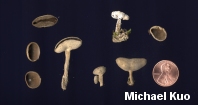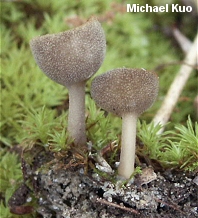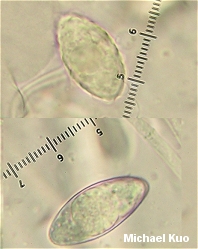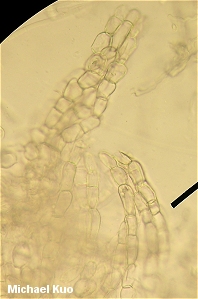| Major Groups > Cup Fungi > Helvella macropus |

|
Helvella macropus [ Ascomycetes > Pezizales > Helvellaceae > Helvella . . . ] by Michael Kuo A handful of Helvella species form a cluster of hard-to-distinguish mushrooms that have cup-shaped or disc-shaped to flat caps and finely hairy, skinny stems that are not prominently ribbed. Among these species, Helvella macropus is unique in having spindle-shaped (or nearly spindle shaped) spores; the spores of look-alike species, including Helvella cupuliformis, are ellipsoid. Be careful assessing this feature, however, because the spores of Helvella macropus are often ellipsoid when immature; sometimes they seem to squeeze themselves into fusoid-ness (I'm pretty sure that's a word) only at the very end of their development. And: the entire group is in desperate need of contemporary study and revision, in my humble opinion, and we are likely to discover someday soon that our traditional notions are inaccurate. Macroscyphus macropus is a synonym. Helvella macropus var. brevis, formerly separated on the basis of its shorter stem and shorter spores, has been synonymized by Abbot & Currah (1997). Description: Ecology: Probably mycorrhizal; growing alone or gregariously on the ground or in moss under hardwoods (especially oaks) or conifers, or on rotting wood; summer and fall--or over winter in warm climates; widely distributed in North America. Cap: 1-6 cm across; cup-shaped or disc-shaped--or occasionally nearly flat; upper surface medium to dark grayish brown, bald; undersurface light to medium grayish brown, finely to prominently pustulate-hairy (especially near the margin). Flesh: Insubstantial. Stem: 1-7 cm long (but usually longer, at maturity, than the cap is wide); 1-5 mm thick; more or less equal; sometimes with clefts near the base; medium brown (usually colored like the undersurface of the cap); whitish near the base; finely hairy or nearly bald with age. Microscopic Features: Spores 18-25 x 10-12.5 µ; fusoid to subfusoid (but occasional ellipsoid spores are often present, especially when still in asci); smooth or roughened; when fresh triguttulate with one large central oil droplet and another, smaller oil droplet at each end, but when revived usually with one large oil droplet and varying smaller droplets. Paraphyses hyaline to ochraceous; apices subclavate, clavate, or subcapitate, 5-10 µ wide. Excipular surface elements hyaline to brownish; often arranged in short to long fascicles; frequently septate; terminal cells subglobose. REFERENCES: (Persoon, 1796) Karsten, 1871. (Fries, 1822; Saccardo, 1889; Smith Weber, 1972; Smith, Smith & Weber, 1981; Breitenbach & Kränzlin, 1984; Arora, 1986; Phillips, 1991/2005; Lincoff, 1992; Abbott & Currah, 1997; Barron, 1999; Roody, 2003; McNeil, 2006; Miller & Miller, 2006.) Herb. Kuo07209401, 05230302, 06010407, 07250701, 06090803. This site contains no information about the edibility or toxicity of mushrooms. |
© MushroomExpert.Com |
|
Cite this page as: Kuo, M. (2012, October). Helvella macropus. Retrieved from the MushroomExpert.Com Web site: http://www.mushroomexpert.com/helvella_macropus.html |



